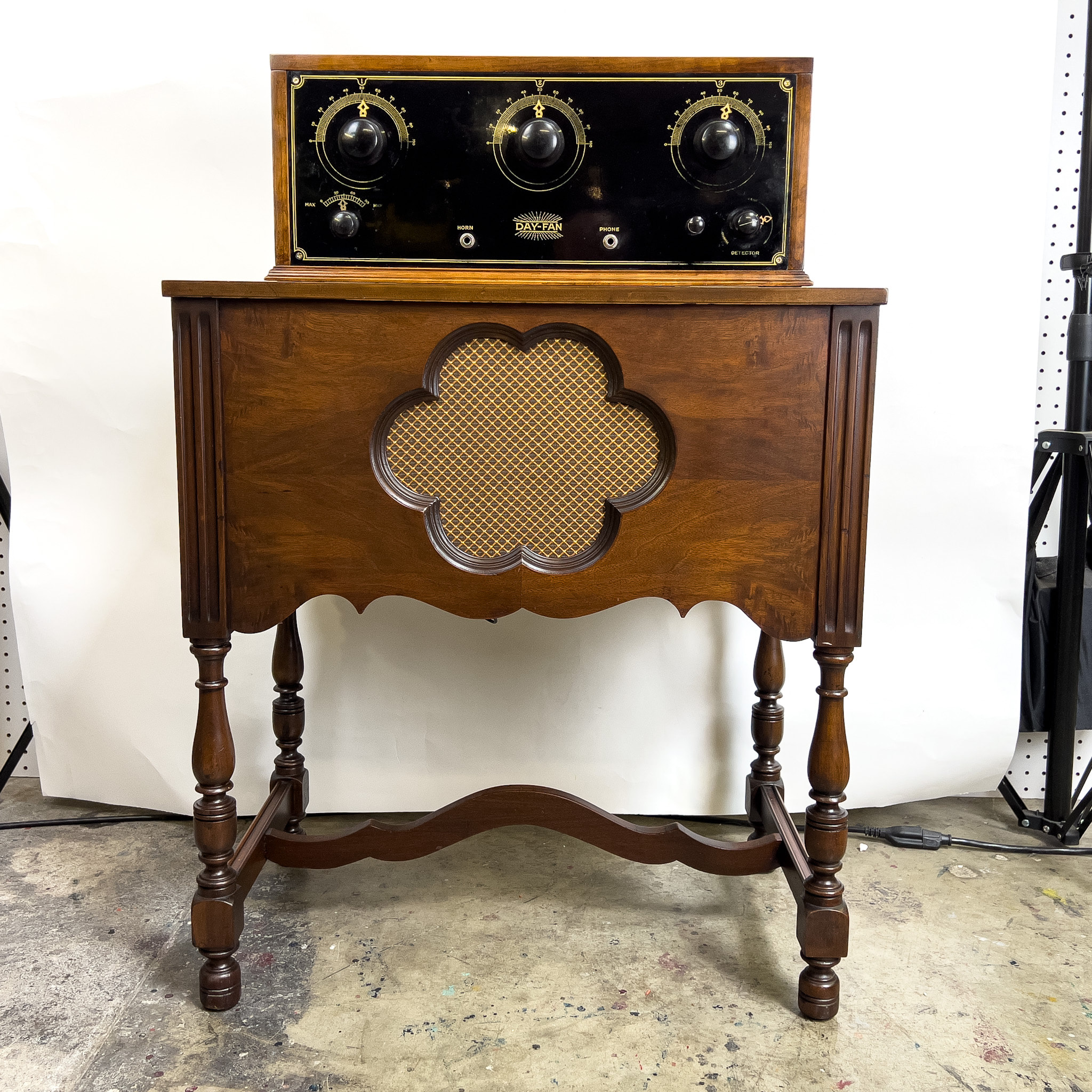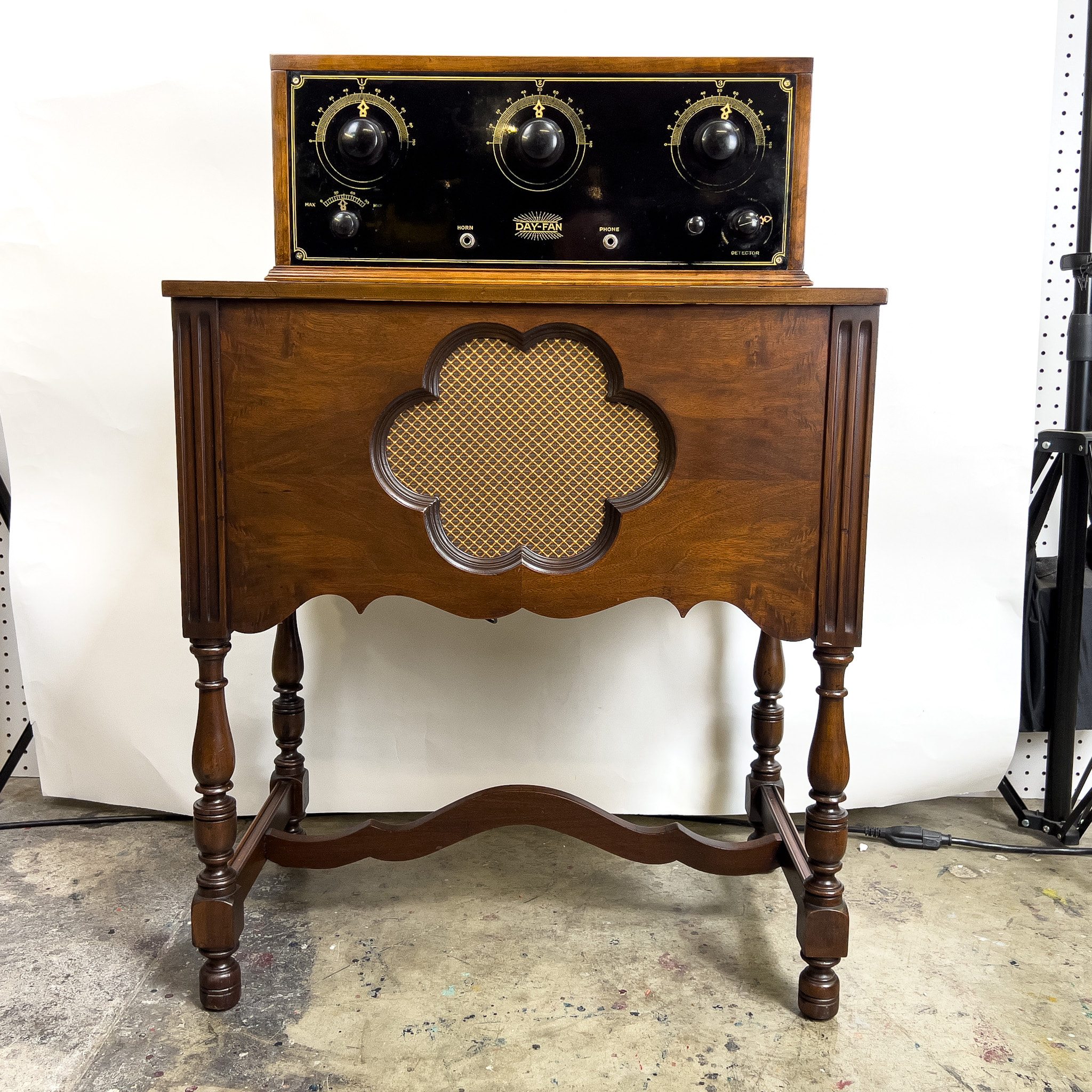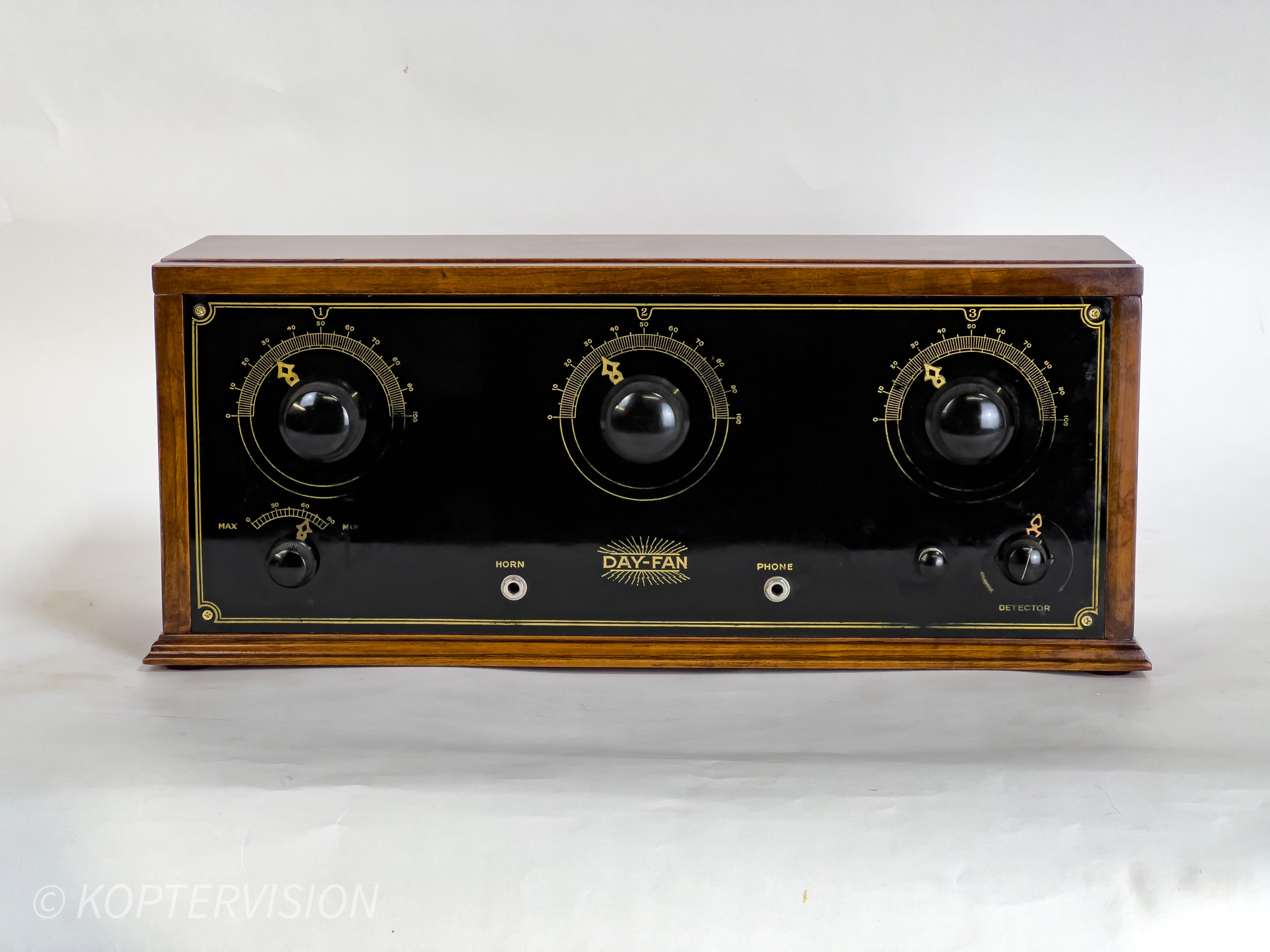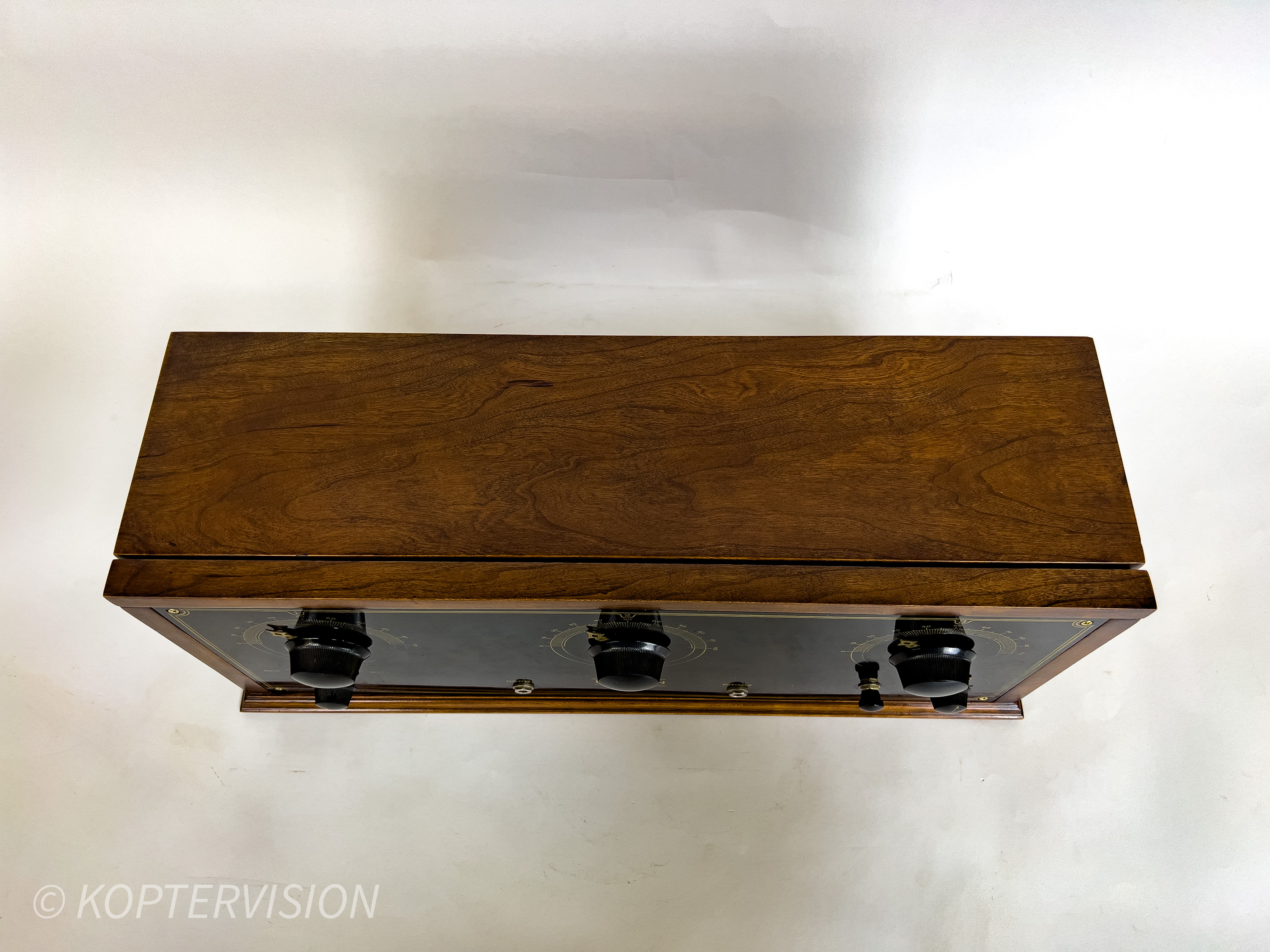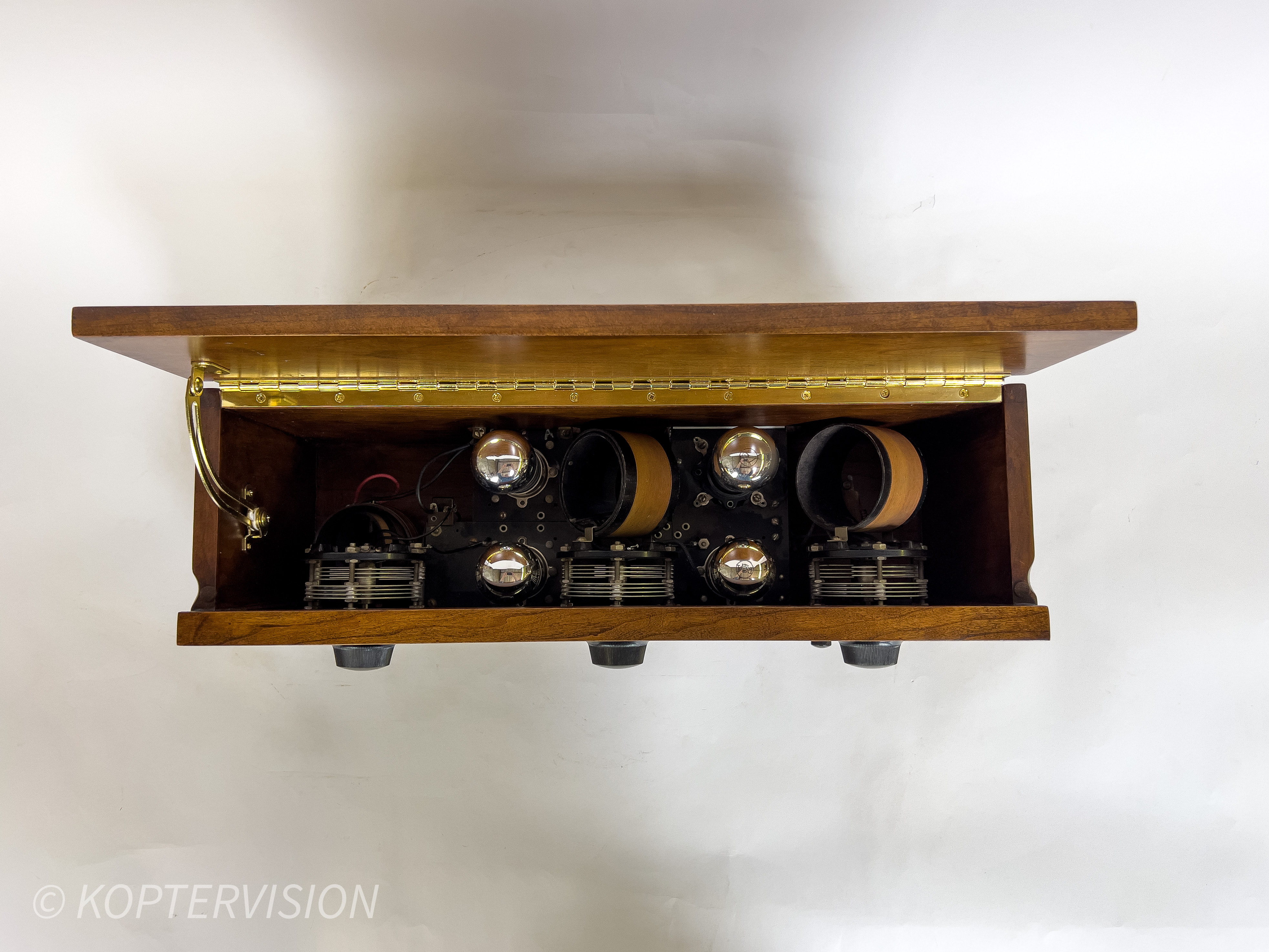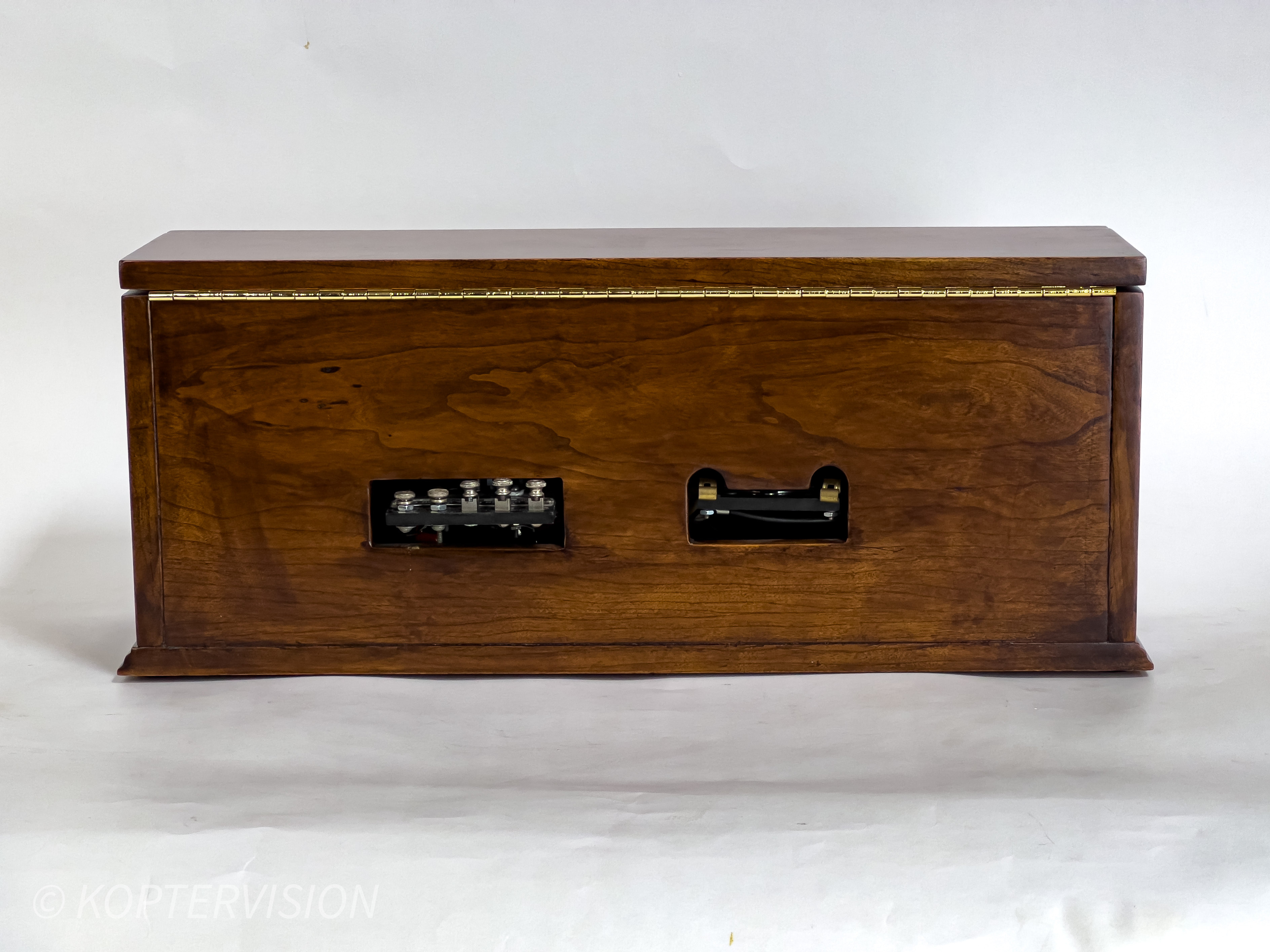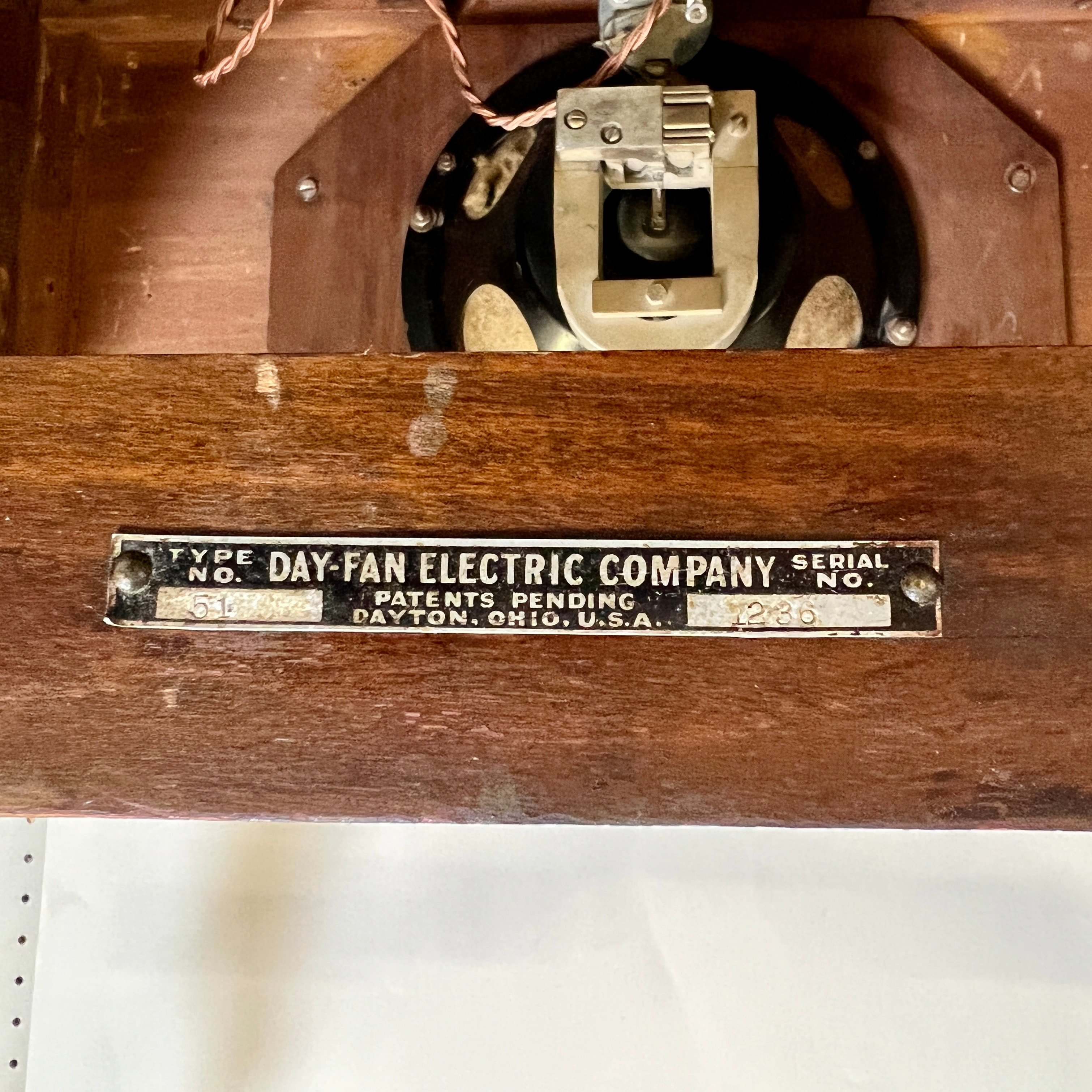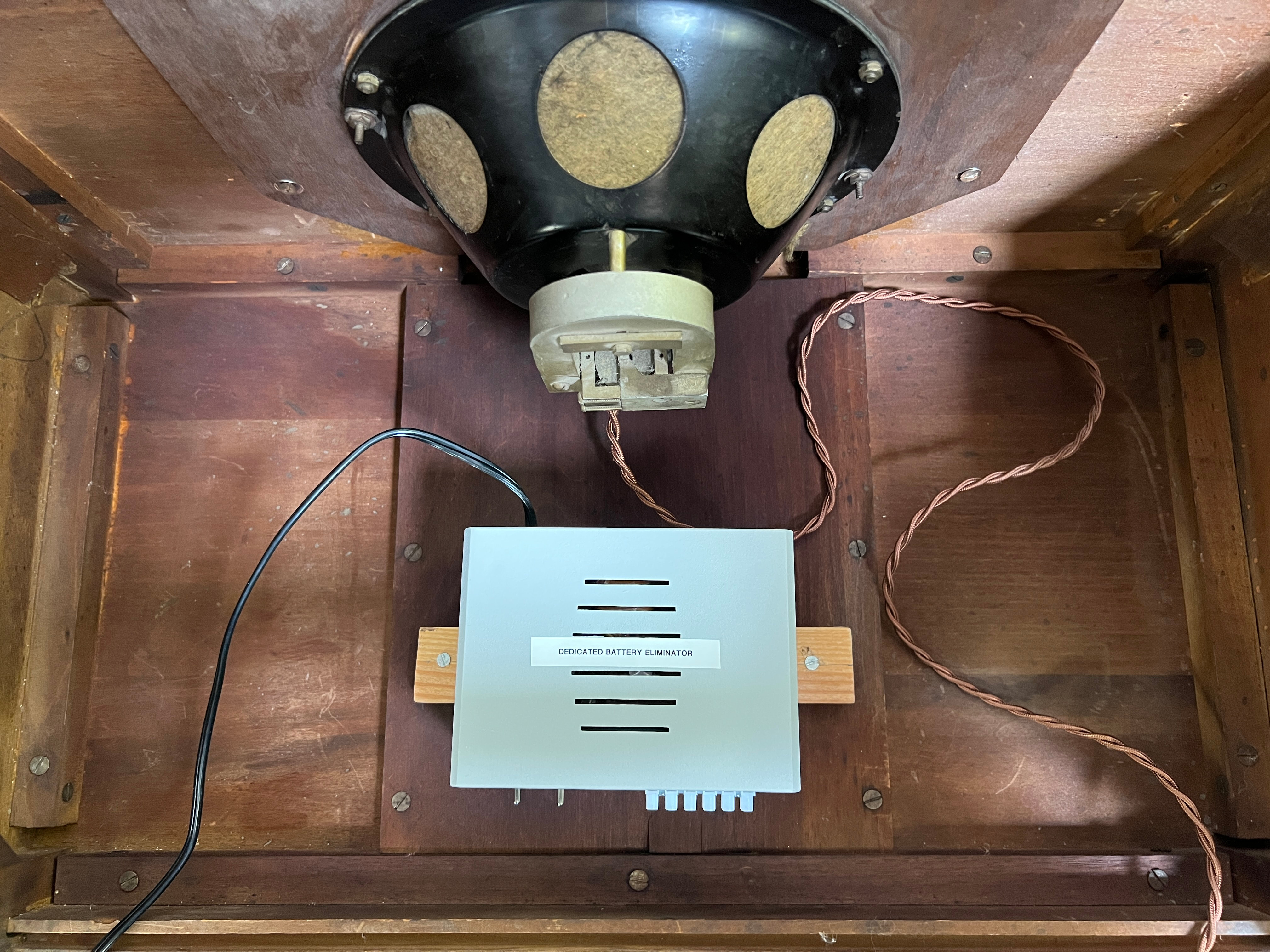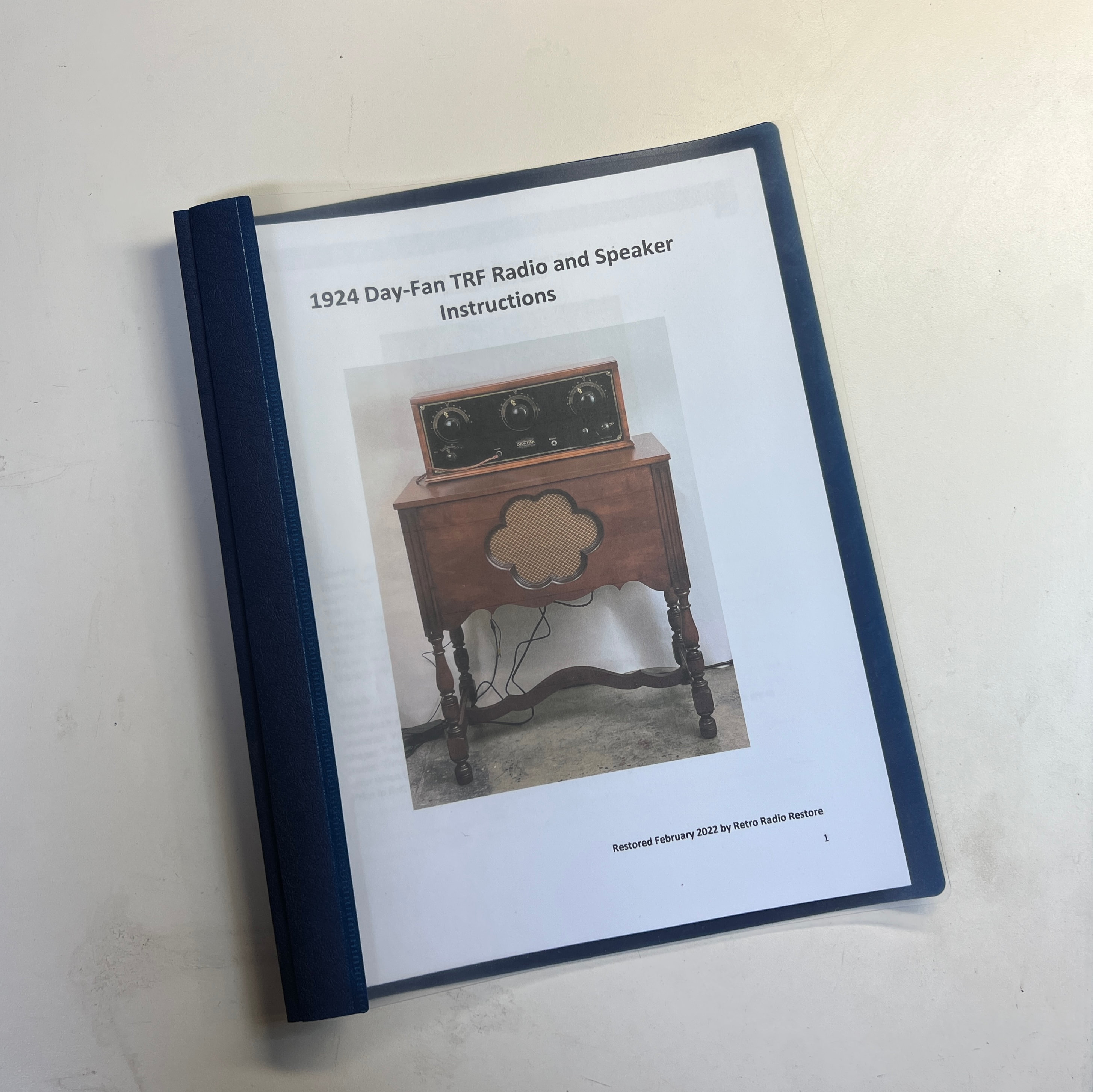- Radios
- >
- Day-Fan OEM 7 5106 Radio and No. 51 Speaker (1924)
Day-Fan OEM 7 5106 Radio and No. 51 Speaker (1924)
SKU:
$600.00
$600.00
Unavailable
per item
DONATED
RADIO
History: This 1924 Day-Fan radio is a superb example of an early TRF receiver. A tuned radio frequency receiver (or TRF receiver) is a type of radio receiver that is composed of one or more tuned radio frequency (RF) amplifier stages followed by a detector (demodulator) circuit to extract the audio signal and usually an audio frequency amplifier. Almost all TRF receivers were originally powered by multiple dry-cell batteries.
The TRF receiver was first patented in 1916. The concept was that each stage would amplify the desired signal while reducing the interfering ones. Multiple stages of RF amplification would make the radio more sensitive to weak stations, and the multiple tuned circuits would give it a narrower bandwidth and more selectivity than the single stage receivers common at that time. All tuned stages of the radio must track and tune to the desired reception frequency. This contrasts with the modern superheterodyne receiver that must only tune the receiver's RF front end and local oscillator to the desired frequencies; all the following stages work at a fixed frequency and do not depend on the desired reception frequency.
TRF receivers were popular in the 1920s. Early examples could be tedious to operate because when tuning in a station, each stage had to be individually adjusted to the station's frequency. Later models used “ganged tuning,” linking together the tuning mechanisms of all stages, and operated by just one control knob. By the mid-1930s, TRF receivers were replaced by the superheterodyne receiver.
Antique TRF receivers can often be identified by their cabinets. They typically have a long, low appearance, with a flip-up lid for access to the vacuum tubes and tuned circuits. On their front panels are typically two or three large dials, each controlling the tuning for one stage. Inside, along with several vacuum tubes, there will be a series of large coils. These will usually be with their axes at right angles to each other to reduce magnetic coupling between them.
Day-Fan began business as Dayton Fan & Motor Company in 1889, manufacturing fans. It produced radio parts from 1922 and complete radios from 1924. In 1929 or 1930, General Motors purchased Day-Fan Radio and did business under the Delco brand. In response to an antitrust suit filed by the Department of Justice in May 1930, RCA and General Motors liquidated GM Radio in November 1931.
Today, this radio is sought after by collectors but almost never found in this near-perfect original condition. We acquired this radio in early 2021 from a collector who had not restored it. Unfortunately, the cabinet was missing. However, the chassis was fully functioning and only needed a cleaning.
Cabinet: The reproduction cabinet for this radio was custom made in Durham, NC, by Byron Snow, a specialty cabinetmaker and woodworker. The wood is Cherry and was stained in Walnut. The finish is flat matte lacquer.
Originally, there were several cabinet variations, with some using clips and others using lugs to make the antenna and ground connections. This chassis had clips, accommodated by the wide hole on the back panel. Every detail duplicates the original, from the piano hinge and friction drop lid support to the finger grooves under the lid.
Chassis: The great thing about TRF receivers is they almost never wear out. This was the case with this one. All we did was test, clean, and lubricate it. Except for two of the four 01A tubes, this set is 100% original and has no modifications.
SPEAKER
Original units of this radio would have been paired with a horn type speaker. On the front panel, the phone jack is labeled for it. However, we decided to pair this radio with a much better sounding and highly collectible Day-Fan No. 51 Speaker Cabinet manufactured in part by Stout-Smith Trust of Salem, Indiana.
History: The original speaker was in bad condition when we first got it. The paper cone was torn, and not worth the investment to repair it. Rather than restore it, we matched the size with another high impedance speaker that did work.
We stripped and refinished the cabinet ourselves, restoring the walnut finish to match the original. We replaced the grill cloth with a period correct cloth. By itself, the speaker is a collector’s item and should last another 100 years.
POWER
Power is supplied to the radio by a custom battery eliminator. It is mounted to the underside of the speaker cabinet. We provided access it via the back panel at the hole which allows the back panel to lift inward. Two power cords (one fixed, one removable) plug in to house AC and five color-coded wires connect the back of the radio.
This matching pair was donated to the California Historical Radio Society and will be used in their educational program.
History: This 1924 Day-Fan radio is a superb example of an early TRF receiver. A tuned radio frequency receiver (or TRF receiver) is a type of radio receiver that is composed of one or more tuned radio frequency (RF) amplifier stages followed by a detector (demodulator) circuit to extract the audio signal and usually an audio frequency amplifier. Almost all TRF receivers were originally powered by multiple dry-cell batteries.
The TRF receiver was first patented in 1916. The concept was that each stage would amplify the desired signal while reducing the interfering ones. Multiple stages of RF amplification would make the radio more sensitive to weak stations, and the multiple tuned circuits would give it a narrower bandwidth and more selectivity than the single stage receivers common at that time. All tuned stages of the radio must track and tune to the desired reception frequency. This contrasts with the modern superheterodyne receiver that must only tune the receiver's RF front end and local oscillator to the desired frequencies; all the following stages work at a fixed frequency and do not depend on the desired reception frequency.
TRF receivers were popular in the 1920s. Early examples could be tedious to operate because when tuning in a station, each stage had to be individually adjusted to the station's frequency. Later models used “ganged tuning,” linking together the tuning mechanisms of all stages, and operated by just one control knob. By the mid-1930s, TRF receivers were replaced by the superheterodyne receiver.
Antique TRF receivers can often be identified by their cabinets. They typically have a long, low appearance, with a flip-up lid for access to the vacuum tubes and tuned circuits. On their front panels are typically two or three large dials, each controlling the tuning for one stage. Inside, along with several vacuum tubes, there will be a series of large coils. These will usually be with their axes at right angles to each other to reduce magnetic coupling between them.
Day-Fan began business as Dayton Fan & Motor Company in 1889, manufacturing fans. It produced radio parts from 1922 and complete radios from 1924. In 1929 or 1930, General Motors purchased Day-Fan Radio and did business under the Delco brand. In response to an antitrust suit filed by the Department of Justice in May 1930, RCA and General Motors liquidated GM Radio in November 1931.
Today, this radio is sought after by collectors but almost never found in this near-perfect original condition. We acquired this radio in early 2021 from a collector who had not restored it. Unfortunately, the cabinet was missing. However, the chassis was fully functioning and only needed a cleaning.
Cabinet: The reproduction cabinet for this radio was custom made in Durham, NC, by Byron Snow, a specialty cabinetmaker and woodworker. The wood is Cherry and was stained in Walnut. The finish is flat matte lacquer.
Originally, there were several cabinet variations, with some using clips and others using lugs to make the antenna and ground connections. This chassis had clips, accommodated by the wide hole on the back panel. Every detail duplicates the original, from the piano hinge and friction drop lid support to the finger grooves under the lid.
Chassis: The great thing about TRF receivers is they almost never wear out. This was the case with this one. All we did was test, clean, and lubricate it. Except for two of the four 01A tubes, this set is 100% original and has no modifications.
SPEAKER
Original units of this radio would have been paired with a horn type speaker. On the front panel, the phone jack is labeled for it. However, we decided to pair this radio with a much better sounding and highly collectible Day-Fan No. 51 Speaker Cabinet manufactured in part by Stout-Smith Trust of Salem, Indiana.
History: The original speaker was in bad condition when we first got it. The paper cone was torn, and not worth the investment to repair it. Rather than restore it, we matched the size with another high impedance speaker that did work.
We stripped and refinished the cabinet ourselves, restoring the walnut finish to match the original. We replaced the grill cloth with a period correct cloth. By itself, the speaker is a collector’s item and should last another 100 years.
POWER
Power is supplied to the radio by a custom battery eliminator. It is mounted to the underside of the speaker cabinet. We provided access it via the back panel at the hole which allows the back panel to lift inward. Two power cords (one fixed, one removable) plug in to house AC and five color-coded wires connect the back of the radio.
This matching pair was donated to the California Historical Radio Society and will be used in their educational program.
